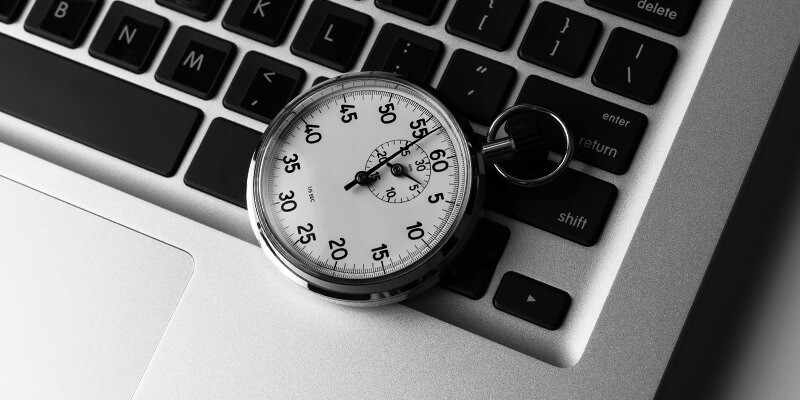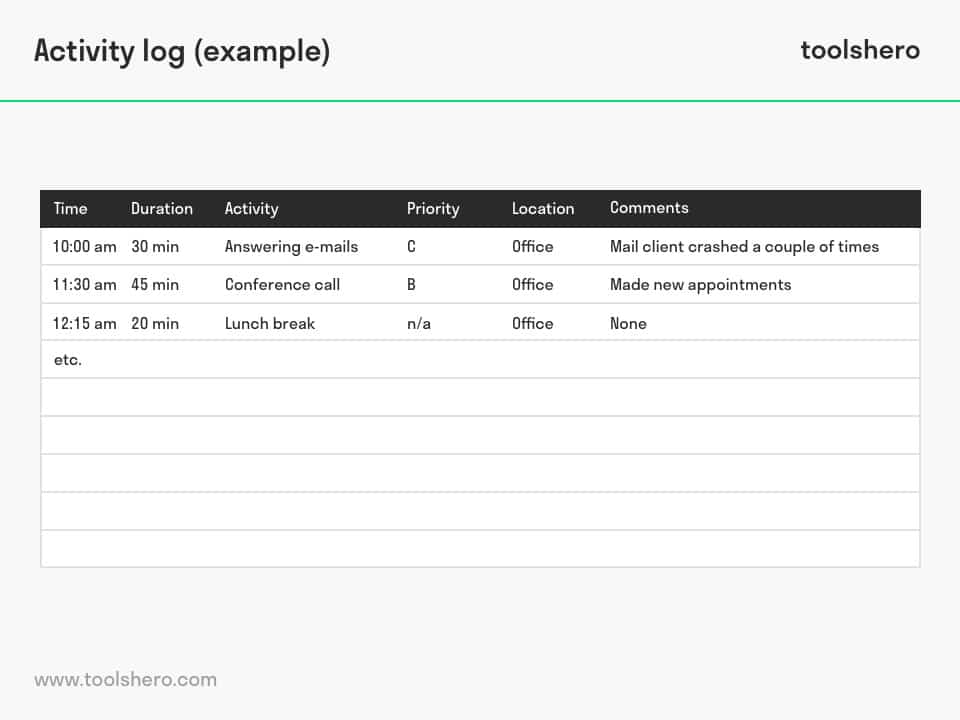Activity Log

Activity Log: this article explains the concept of an Activity Log in a practical way. After reading, you’ll understand the basics of this powerful effectiveness and time management tool. This article also contains a downloadable and editable Activity Log template.
What is an Activity Log?
Time is a scarce resource. Sensible management of it is therefore very important to all entrepreneurs and employees. An activity log is a document that describes how, where and when time is spent.
An activity log can be used for business purposes, but can also be advantageous for tracking activities in other situations. In the workplace, however, it can provide insight into the amount of time spent carrying out a specific task, the time available for lunch and the time spent per day on checking emails etc.
Keeping an activity log is also one of the most effective ways of determining where time is wasted. Specific cases can then be isolated, and a method can be found to work more efficiently. Keeping track of and analysing activities can lead to considerable time gains. Afterwards, time can be better categorised, resulting in a more efficient and productive working schedule.
Many people do not realise that wasting a few minutes every day can cost a lot of time and money in the long term. After all, our brains are not very efficient when it comes to short amounts of time being spent on certain matters and the realisation thereof.
This is not necessarily due to people’s inability, but due to short-term information that the brain does not transmit to long-term memory storage. Keeping an activity log is therefore highly advisable.
An activity log is a step-by-step plan
- Register all activities as they occur. Also note interruptions such as breaks and note down details. To ensure accuracy, it is important not to wait until the end of the day or week.
- Assign a certain priority to every activity. Use the letters A, B or C or use the Action Priorities Matrix.
- Subsequently note how each activity can be improved upon. The more details, the better.
- Keep the daily activity log for at least a week. A shorter time span is only recommended if daily tasks are always similar. Generally speaking, a week is the minimum to gain proper insight into activities during a regular working week.
Analysis of time use
Collecting data in an activity log is not useful if no analysis is performed, and no possible changes are implemented. The essence of data analysis is categorising time spent and aligning it with personal goals or tasks.
There are different ways to compare this, but one example is the categorisation of working objectives with regard to short, medium and long term. Next, examine what the most time is spent on and determine whether objectives can be realised with this particular distribution of time.
When categorising activities, also consider fluctuations in energy during the day. After all, everyone has times at which their focus is higher or lower. Conduct the most valuable activities at times when energy levels and focus are high. Important here is the identification of a mismatch between the activities and the times at which they are conducted.
The checking and deleting of unread emails is often an example of such a mismatch. For many people, the morning hours are the most productive. Regardless, a lot time is spent on reading and replying to unimportant emails during this time of the day. Always consider reading unimportant emails at the end of the day.
Activity Log example
Logging and regulations
In many countries, keeping an activity log is mandatory in certain sectors. For example, commercial motor vehicles with their own engine or towed vehicles, such as lorries or buses, must have their own electronic logging device. In the United States, such a device is known as an Electronic Logging Device (ELD).
In Europe, on the other hand, it is referred to as a tachograph. This device records the driving time, location and engine hours. The device, and the requirement to use it, is intended to create a safe environment for drivers and other road users.
Drivers often drive long distances and are not allowed to drive too many hours in a row in order to prevent fatigue. The device also registers the speed of the lorry, which is legally determined at a certain speed.
In the past, paper logs would be kept by the driver himself. However, due to the ease of manipulating these logs, an electronic alternative was introduced. In March 2016, a European regulation introduced new requirements for the development, setup and operation of new smart tachographs.
These will be introduced starting in 2019 and have been developed to address security risks. The new smart tachographs are connected to the global navigation satellite system (GNSS) and make it easier for government agencies to check drivers and companies.
Tips for keeping an activity log
- Be consistent
- Be accurate
- Try to keep different logs, based on time and activities. Determine what works best for you
- Do not wait too long to note down activities
- Also keep track of the time in which there are no activities
- For each activity, note whether or not it was planned in advance
Activity Log template
Do you want to start tracking your time spend on activities? Get started with this ready to use Activity Log template, in Excel format.
Download the Activity Log template
This template is exclusively for our paying Toolshero members. Click here to see if a membership is something for you!It’s Your Turn
What do you think? Are you familiar with the explanation of an activity log? Do you keep an activity log yourself? What do you think are important aspects contributing to effective time management? How do you ensure your working hours become more efficient and productive?
Share your experience and knowledge in the comments box below.
More information
- Macan, T. H. (1996). Time-management training: Effects on time behaviors, attitudes, and job performance. The Journal of psychology, 130(3), 229-236.
- Claessens, B. J., Van Eerde, W., Rutte, C. G., & Roe, R. A. (2007). A review of the time management literature. Personnel review, 36(2), 255-276.
How to cite this article:
Janse, B. (2018). Activity Log. Retrieved [insert date] from Toolshero: https://www.toolshero.com/personal-development/activity-log/
Add a link to this page on your website:
<a href=”https://www.toolshero.com/personal-development/activity-log/”>Toolshero: Activity Log</a>
Published on: 29/12/2018 | Last update: 08/03/2022













